
- Topics 1531
- Industrial 59
- Troubleshooting Guides 31
- Restaurant Management 140
- Bar Management 66
- Catering Tips 38
- Bakery Management 47
- Food Trucks & Concessions 47
- Advertising & Marketing 40
- Eco-Friendly Tips 12
- Facility Layout & Design 50
- Coffee Shop Tips 31
- Installation & Maintenance 59
- Janitorial & Pest Control 35
- Safety & Sanitation 110
- Startup Tips 113
- Menu Design 11
- Kitchen & Cooking Tips 104
- Hospitality Management 24
- Pizza & Sandwich Shop Tips 30
- Smallwares 40
- Food Prep 101
- Tabletop Items 19
- Disposables 26
- Calculators & Tools 8
- Consumables 70
- Warewashing & Laundry 21
- Cooking Equipment 101
- Food Storage & Refrigeration 54
- Beverage Equipment 39
- Office Supplies 5
Cheese, a widely cherished ingredient in the culinary world, has a rich history and is an integral part of almost every cuisine worldwide. Different types of cheese are made from varying milk, methods, and aging times and processes. Cheese is used in thousands of different applications, from sophisticated charcuterie boards to simple sandwiches.
Shop All Cheese
Click the following links to navigate to each type of cheese:
How Are Different Types of Cheese Made?
Cheeses vary in their characteristics, which are determined by factors such as the source of milk, the geographical location where the animal grazes, the animal's diet, the cheese-making process, and the duration of aging. The natural environment in which the animal lives is one of the ways a cheese achieves its taste. These natural occurrences that affect the milk for the cheese are known as terroir. A region's terroir is one of the reasons why there are different styles and tastes between different types of cheese around the world.
Some cheese's terroir is so coveted that there are legal protections in place that state only a certain type of cheese can be made in a specific region of the world. Take parmesan and Parmigiano-Reggiano cheese for example. Parmigiano-Reggiano is protected by Italy's Denominazione di Origine Protetta (translating to "Protected Designation of Origin"), certifying it can only be made in Parma, Modena, and Reggio Emilia. If a cheesemaker lives anywhere else in the world and wants to produce their own Parmigiano-Reggiano and follows all of the same production steps, it would still not be considered Parmigiano-Reggiano as it does not have the same terroir as it would in the certified Parmigiano-Reggiano regions. That cheese would then be called "parmesan".
Different Types of Cheese
Whether you're trying to find the best cheese for pizza or your authentic pasta dishes, it's important to understand what makes different types of cheese unique. Since types of cheese are listed by firmness, moisture levels play an important role in the selection process. Higher moisture content results in a softer cheese, while lower moisture content that is densely packed into cheese molds results in a harder cheese. Sometimes certain cheese types are freshly made and eaten that day, other times cheeses are left to age for months - even years! The longer the cheese ages, the more complex the flavors become.
There are thousands of types of cheese in the world, so we've compiled a types of cheese list that classifies them into six categories based on texture: blue cheese, fresh, soft, semi-soft, semi-hard, and hard. Below are the most common types of cheese found in each variety.
Types of Blue Cheese
Blue cheese is the most complex of all cheeses. It's rich and creamy like soft cheese, yet pungent and perfumed like hard cheese. Blue cheese starts out being made like any other cheese, but what's different about blue cheese is the introduction of a highly desired mold growth. This is usually done by injecting a Peniciliium culture into the cheese, or lightly packing in the cheese curds to promote oxidation and create safe mold growth.
"Needling" is also crucial to gain more blue veins in the paste. Needles are pierced throughout the cheese to create more cavities for mold to grow. Blue cheese is then left to age in a dark cave, specifically one dedicated solely to blue cheese so the bacteria does not interact with other cheeses' flavor profiles. Blue cheeses can be aged from a few months to a few years, and they are extra sharp and salty from the moisture loss and added salt to preserve them for aging. Below are the most common types of blue cheese.

Gorgonzola
Gorgonzola is a type of cheese that comes from the Lombardy region of Northern Italy. Gorgonzola is made from unskimmed cow's milk and has a buttery and piquant flavor with an incredibly soft and delicately crumbly texture.
Known as a "dessert" cheese, Gorgonzola is great on a charcuterie board when sitting next to grapes, honey, and pistachios. Try also using Gorgonzola on a sweet salad or perfectly browned steak, and pair the cheese with a glass of Zinfandel or Sauternes.
- Milk Type: Cow
- Taste: Buttery and piquant
- Texture: Soft yet crumbly
- Accompaniments: Grapes, honey, pistachios
- Gorgonzola Wine Pairing: Zinfandel and Sauternes

Roquefort
Roquefort is a type of blue cheese that comes from Southern France, specifically Roquefort-sur-Soulzon, where it's aged in the natural Combalou caves for five months. Roquefort is made with sheep milk and has a large flavor profile of robust pungency and metallic tang but balanced out with sweet burnt caramel notes. The texture is moist, soft, crumbly, and cratered, which are all signs of good blue cheese.
Roquefort is used a lot in quiches, tarts, and even pasta dishes. If you're placing Roquefort on a charcuterie board, make sure it's next to a soft cheese like Brie or Camembert, with accompaniments such as nuts, winter fruits, and jam. Pair with a sweet wine like Sauternes, Port, Sherry, or Ice Wine to round out the taste.
- Milk Type: Sheep
- Taste: Pungent, sweet burnt caramel, metallic tang
- Texture: Moist, soft, crumbly, cratered
- Accompaniments: Walnuts, almonds, hazelnuts, figs, pears, apples, truffles, caramelized onions, chutney, jams
- Roquefort Wine Pairing: Sauternes, Port, Sherry, Ice Wine

Stilton
Stilton is a type of blue cheese that can only be made in three specific counties of England: Nottinghamshire, Leicestershire, and Derbyshire. Stilton is made with cow's milk and has a very powerful flavor profile: earthy, robust, peppery, and grassy with hints of mushroom. The texture is creamy and flaky with a loose crumb thanks to cheese makers turning the Stilton wheels daily while aging to never compress the curd.
Stilton pairs well with honey, pecans, plums, grapes, nut bread or crackers, and dates. When making recipes, use Stilton in salads and dips, or on top of potatoes, frittatas with meat, or flatbreads. For a drink pairing, Stilton goes well with both wine and beer, so reach for a Porter, Stout, Sherry, or Cabernet Sauvignon.
- Milk Type: Cow
- Taste: Robust, strong, earthy, mushroomy, grassy, peppery
- Texture: Creamy with a loose crumb
- Accompaniments: Honey, pecans, potatoes, plums, grapes, dates, meat, nut bread
- Stilton Wine and Beer Pairings: Porter, Stout, Sherry, Cabernet Sauvignon
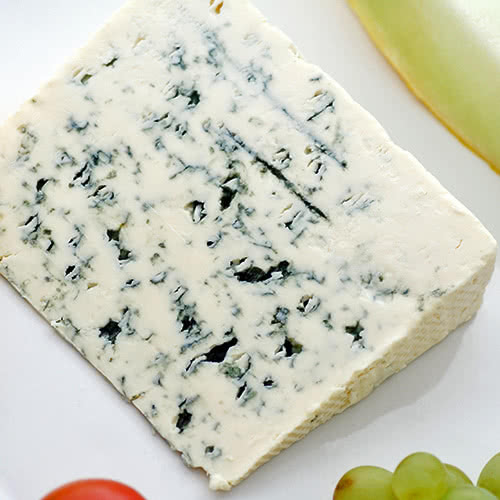
Danablu
Danablu cheese is a type of Danish cheese made on the island of Funen. This cow's milk cheese is sharp and pungent, but it's the mildest option of almost all blue cheeses and is a great choice for those just being introduced to this type of cheese. The texture is smooth and crumbly with a beautiful, rich consistency.
The best accompaniments for Danablu are apples, pears, candied nuts, dark chocolate, and rye bread. If you want to use Danablu in a recipe, use it on pasta, in soups, or on top of burgers. Danablu is great with meat such as beef, veal, and pork and pairs nicely with wine such as Cabernet and Gewurztraminer.
- Milk Type: Cow
- Taste: Sharp and pungent
- Texture: Smooth and crumbly
- Accompaniments: Apples, pears, dark chocolate, rye bread, candied nuts, beef, pork
- Danablu Wine Pairing: Cabernet or Gewurztraminer
Types of Fresh Cheese
Fresh cheese is unaged, unripened, rindless, and has the same bright, white color on the inside and out. The texture varies depending on how the paste is made, but the taste is usually mild, slightly acidic, and only lends a small hint of flavor. Since fresh cheese has the highest moisture content, it can be rolled in various herbs, spices, crumbled nuts, cut fruit, and even edible flowers.

Mozzarella
Mozzarella is a type of cheese that comes from Southern Italy where it's made with buffalo milk, while in America it's made with cow's milk. Mozzarella is a fresh cheese that does not have any aging processes at all. In fact, it's best eaten the same day it's made.
Mozzarella tastes mild and milky and has just a hint of acid. Its creamy and elastic texture makes it one of the best cheeses for pizza and lasagna and makes an excellent cheese for a salad that has grilled vegetables, balsamic, and chicken. It's also famous for a Caprese salad with tomatoes, basil, and olive oil. Pair Mozzarella with an Italian red wine like Lambrusco or Valpolicella to complement the cheese's milky and mild flavor.
- Milk Type: Buffalo or cow
- Taste: Mild, milky, slightly acidic
- Texture: Creamy and elastic
- Accompaniments: Olive oil, tomatoes, basil, balsamic, grilled vegetables
- Mozzarella Wine Pairing: Valpolicella or Lambrusco
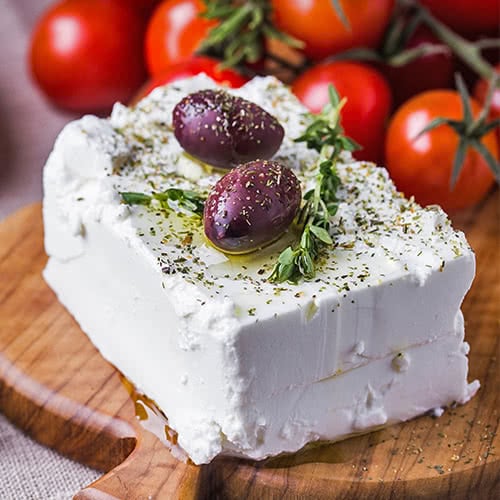
Feta
Feta is a type of fresh cheese that comes from the mainland of Greece. Once Feta cheese is made and formed into a block, it is pickled in a brine which gives it a salty, tangy, pungent, and intense flavor. It’s made from sheep’s milk - or sometimes a mixture of goat and sheep’s milk - and has a brittle, dry, and grainy texture.
On a charcuterie board, put Feta next to stone fruits, melons, and honey. Feta is unbeatable in recipes with cucumbers, tomatoes, and red onions, such as Greek salads. It also pairs well with dill, watermelon, eggplant, fava beans, eggs, pita bread, and chickpeas. However you enjoy Feta, pair it with a glass of Rose, Pouilly-Fume, or Sauvignon Blanc.
- Milk Type: Sheep and/or goat
- Taste: Tangy, salty, pungent, intense
- Texture: Brittle, dry, grainy
- Accompaniments: Cucumber, tomato, red onions, eggs, stone fruit, melons, chickpeas, dill, watermelon, eggplant, fava beans, pita bread
- Feta Wine Pairing: Rose, Pouilly-Fume, Sauvignon Blanc
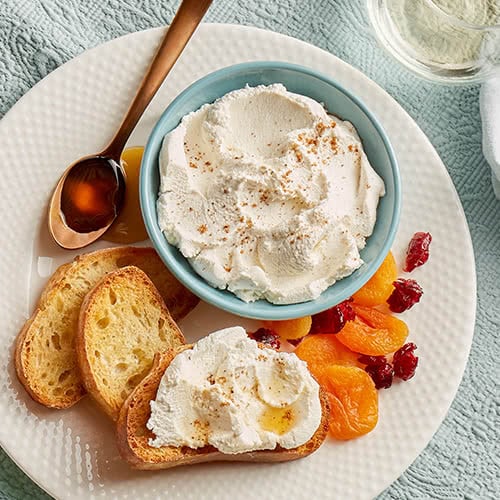
Ricotta
Ricotta cheese is a type of Italian cheese that translates to "recooked" in Italian. When making any type of cheese, the milk is separated into curds and whey. Curds are what's used to make the cheese, and the whey is the leftover liquids, which usually have a very small amount of curds leftover. These leftover curds are heated with acid and coagulated, becoming thicker and larger. It's then strained through a cheesecloth and what's left is the ricotta.
This thick, creamy, fluffy, and spongy cheese can be made from cow, sheep, goat, or buffalo milk. Ricotta has a mild, fresh, and slightly sweet flavor profile that pairs well with honey, strawberries, pistachios, chocolate, pasta, pesto, and tomatoes. It's used for filling pasta shells, ravioli, lasagna, and cannolis, and can top pizzas, flatbreads, and crostinis. Pair ricotta with Riesling, Rose, or a low-tannin red wine such as Gamay, Lambrusco, and Barbera.
- Milk Type: Cow, sheep, goat, or buffalo
- Taste: Mild, fresh, slightly sweet
- Texture: Thick, creamy, spreadable, spongy
- Accompaniments: Honey, strawberries, pistachios, chocolate, pasta, pesto, tomatoes
- Ricotta Wine Pairing: Riesling, Rose, Gamay, Lambrusco, Barbera
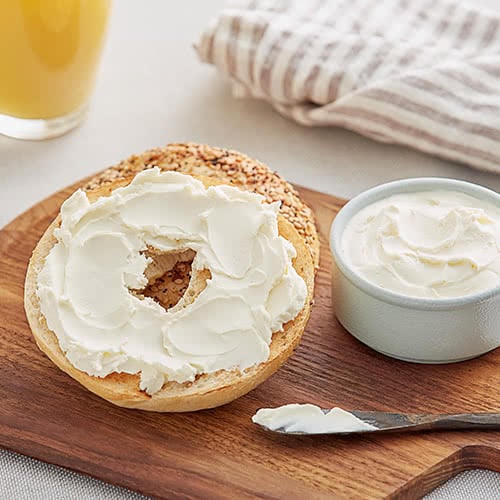
Cream Cheese
Cream cheese is a type of fresh cheese made from cow's milk. Cream cheese started from the well-known French cheese Neufchatel, but it was enriched with the addition of extra cream, giving us the cream cheese we know today. It's mild, milky, rich, and slightly acidic with a thick, homogenous, and spreadable consistency.
Cream cheese is most commonly known as a topping for any type of bagel. Cream cheese can be enhanced with fruits, vegetables, herbs, and spices such as scallions, chives, garlic, strawberries, and blueberries, to name a few. It's also the main ingredient in cheesecake and can be used in many baking applications as a rich filling.
- Milk Type: Cow
- Taste: Mild, milky, slightly acidic, rich
- Texture: Thick, homogenous, creamy, spreadable
- Add-ins: Scallions, chives, roasted garlic, black pepper, honey, mint, dried cranberries, orange zest, dark chocolate
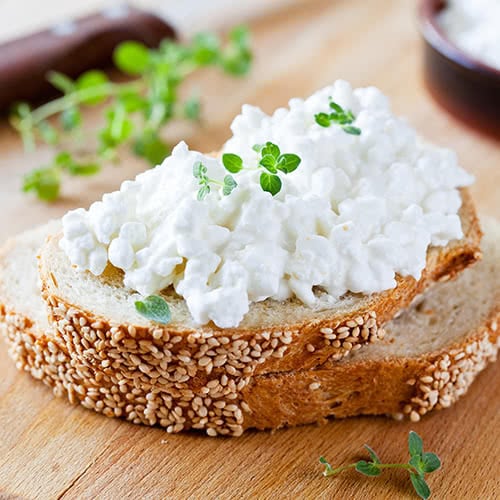
Cottage Cheese
Cottage cheese is known as one of the healthiest types of cheese thanks to its high protein and lower calorie count. It's made from cow's milk and has a mild, milky, and slightly acidic taste. Cottage cheese is famously lumpy with a thick and spoonable texture.
Cottage cheese is well-known for being a breakfast food, dressed up with berries, peaches, bananas, pineapple, granola, and honey. It can also be used as a binding ingredient in baked goods and pancakes, and it also makes a great addition to pasta sauces or whipped in a food processor and used as a dip.
- Milk Type: Cow
- Taste: Mild, milky, slightly acidic
- Texture: Lumpy, thick, spoonable
- Accompaniments: Berries, peaches, bananas, pineapple, granola

Mascarpone
Mascarpone is a type of cheese that originated in the Lombardy region of Northern Italy. It's made from cow's milk and has a rich, sweet, buttery, and slightly tangy taste with a spreadable and creamy texture.
Mascarpone is famously used to make tiramisu. It can also be used as an ingredient in frosting for cakes, or an oil or binding agent in a quick bread. For a savory application, mascarpone is great when stuffed into chicken breasts or used to thicken pasta sauces. However you use it, pair it with a glass of fizzy Moscato or Lambrusco.
- Milk Type: Cow
- Taste: Slightly sweet, rich, buttery, slightly tangy
- Texture: Spreadable and creamy
- Accompaniments: Strawberries, figs, chocolate shavings, honey
- Mascarpone Wine Pairing: Moscato or Lambrusco
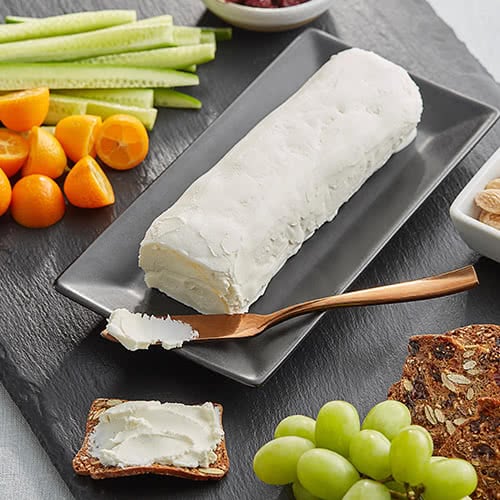
Goat Cheese
Goat cheese is a type of fresh cheese that is believed to have originated in the Mediterranean or Middle East. Goat cheese, also known as Chevre, is made from goat's milk and has a bright and tangy flavor. It's plump, moist, wonderfully creamy, and spreadable.
This type of cheese is extremely easy to pair with sweet or savory ingredients. For a charcuterie board, put goat cheese next to strawberries, almonds, pecans, figs, and cranberries. It's the perfect cheese for a salad or sandwich, too, especially if beets, arugula, and balsamic are present. As far as wine pairings go, reach for Sauvignon Blanc or a Spanish Albarino.
- Milk Type: Goat
- Taste: Bright, tangy, a little sweet
- Texture: Plump, creamy, moist
- Accompaniments: Figs, balsamic dressing, arugula, whole wheat bread, baguette, beets, strawberries, almonds, pecans, cranberries
- Goat Cheese Wine Pairing: Sauvignon Blanc or Spanish Albarino
Types of Soft Cheese
Soft cheeses are ripened between 1-2 weeks. They contain a high moisture and fat content which creates a pudding-like paste, especially if served at room temperature, which is recommended. Soft cheeses have a rich, velvety, and silky interior. It's enwrapped in a thin, almost translucent rind which can range in color and texture from pillowy to wrinkly, gray to blue, and fuzzy to fluffy.
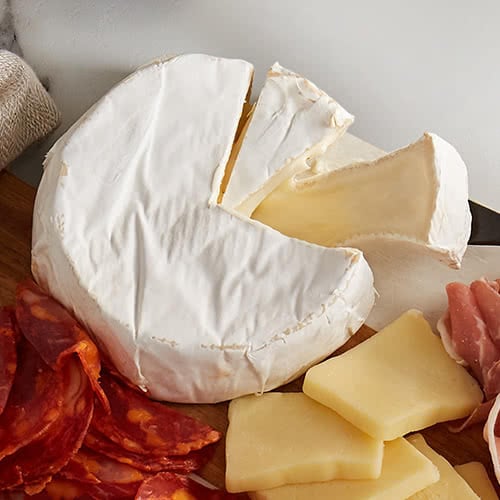
Brie
Brie is a type of cheese that comes from Seine-et-Marne in Northern France. Brie is known as the "Queen of Cheeses" and is beloved for its light, buttery, salty taste and smooth, creamy texture. Brie has a thick paste that turns wonderfully runny when left at room temperature and has an edible bloomy outer rind.
Brie is one of the most popular types of cheese to grace a charcuterie board. Place this cheese next to green apples, pears, fig jam, honey, raspberries, pecans, and cherries. Puff pastry can also be wrapped around Brie and baked in the oven to make a heavenly brie-en-croute. You can also use Brie on a salad or in a panini with turkey and cranberry jam. Pair your Brie with a glass of Beaujolais, Riesling, Champagne, or Chardonnay.
- Milk Type: Cow
- Taste: Light, buttery, slightly salty
- Texture: Silky, smooth, creamy
- Accompaniments: Green apples, pears, fig jam, honey, raspberries, cherries, pecans, turkey, cranberries
- Brie Wine Pairing: Beaujolais, Riesling, Champagne, Chardonnay
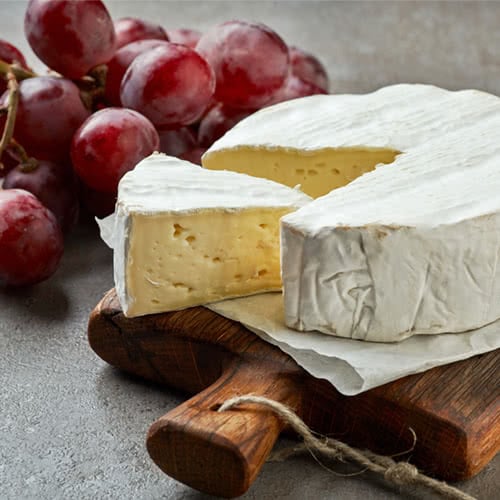
Camembert
Camembert is a type of soft cheese that is very similar to Brie but has a more rustic taste. Camembert comes from Normandy, France, and has an umami, earthy, and grassy taste and a velvety, thick, squidgy, and sticky texture.
When setting out Camembert on a cheese board, place it next to dried apricots, fresh strawberries, cantaloupe, apples, chocolate, and candied pecans with slices of baguette. Camembert is also excellent when baked and served with honey, herbs, and different types of bread that are toasted. You can also use Camembert in a French cheese tart or quiche or as an ingredient in a toasted cheese sandwich. Pair Camembert with a glass of Cotes du Rhones, Gewurztraminer, or Chenin Blanc to round out its savory flavors.
- Milk Type: Cow
- Taste: Hay, umami, earthy, grassy
- Texture: Velvety, thick, squidgy, sticky
- Accompaniments: Cantaloupe, dried apricots, strawberries, apples, chocolate, candied pecans, baguette
- Camembert Wine Pairing: Cotes du Rhones, Gewurztraminer, Chenin Blanc

Chaource
Chaource is a type of cheese that comes from the village of Chaource in the Champagne region of France. This cow's milk cheese can come in two different forms: a young soft cheese and an aged soft cheese. The young version is tangy in flavor and a bit drier than other soft cheeses. The aged version tastes complex and buttery with hints of nuts and mushrooms, while the center is fudgy and oozing at room temperature.
The best accompaniments for Chaource are fig jam, dried fruits, nuts, and slices of baguette. It's also a great cheese to use in a potato au gratin or elevated mac and cheese. Pair Chaource with a glass of Chablis, Sancerre, or Champagne.
- Milk Type: Cow
- Taste: Buttery and complex
- Texture: Fudgy
- Accompaniments: Baguette, fig jam, dried fruits, nuts
- Chaource Wine Pairing: Chablis, Sancerre, Champagne
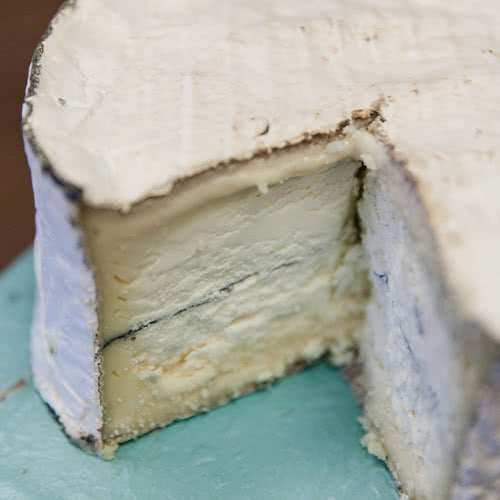
Humboldt Fog
Humboldt Fog is a type of cheese that's made in California and named after the famous fog that rolls into Humboldt Bay. This soft-ripened cheese is made from goat's milk and has a clean, creamy, and floral taste with a smooth yet slightly crumby texture.
This cheese pairs well with Marcona almonds, apples, prosciutto, honey, fennel, pear, pecans, and dark chocolate. It's the perfect cheese to top a salad with, while also being a great cheese for quiches, savory croissants, and danishes. Pair Humboldt Fog with a glass of sparkling wine, Rose, an IPA, or a Porter.
- Milk Type: Goat
- Taste: Creamy and floral
- Texture: Smooth and crumbly
- Accompaniments: Marcona almonds, apples, prosciutto, honey, fennel, pear, pecans, dark chocolate
- Humboldt Fog Wine and Beer Pairings: Sparkling wine, Rose, IPAs, Porters
Types of Semi-Soft Cheese
Semi-soft cheeses have a more al-dente bite thanks to being lightly pressed into their molds, squeezing out a bit of liquid but not too much. Their rinds can range anywhere from sticky and thin to coarse and leathery. The thinner rinds are more buttery, sweet, and mild, while the thicker rinds are more dense, pungent, and earthy. These thicker rinds are formed from molds growing on the cheeses that are regularly brushed off with a saltwater brine, giving a tender dimension to an otherwise creamy interior.

Havarti
Havarti is a type of cheese that originated in Denmark. This cow's milk cheese tastes sweet and sharp with notes of cultured butter and a smooth, supple, creamy, and elastic texture.
Pair Havarti with figs, raisins, walnuts, rustic bread, dill, tomatoes, beef, and different types of mushrooms. Havarti makes a great melting cheese, so use it in recipes like cheese puffs, sandwiches, burgers, beer cheese dip, and mac and cheese. For drink pairings, reach for a glass of Chardonnay, Sauvignon Blanc, Merlot, Pinot Noir, Pilsner, a mild Lager, or an IPA.
- Milk Type: Cow
- Taste: Cultured butter, sweet, and sharp
- Texture: Smooth, supple, creamy, elastic
- Accompaniments: Figs, raisins, walnuts, rustic bread, dill, tomatoes, mushrooms, beef
- Havarti Wine and Beer Pairings: Chardonnay, Sauvignon Blanc, Merlot, Pinot Noir, Pilsner, mild Lagers, IPAs

Munster
Munster is a type of semi-soft cheese that originated in France's Alsace, Lorraine, and Franche-Comte regions. Munster is a cow's milk cheese that has a strong and pungent taste and a soft and supple texture.
For accompaniments, Munster pairs well with apples, pears, spinach, mustard, turkey, ham, and beef. Try using it in recipes like quiche, savory puff pastry pockets, and paninis. As far as wine pairings go, reach for Gewurztraminer and Riesling. Also, Munster goes with many different types of beer such as Belgian Ales, Lagers, Porters, and Stouts.
- Milk Type: Cow
- Taste: Strong and pungent
- Texture: Soft and supple
- Accompaniments: Apples, pears, spinach, mustard, turkey, ham, beef
- Munster Wine and Beer Pairings: Gewurztraminer, Riesling, Belgian Ales, Lagers, Porters, Stouts

Provolone
Provolone is a type of cow's milk cheese that originated in Southern Italy. This cheese tastes buttery and sharp and has a pleasantly smooth, silky, and firm texture that makes it a great melting cheese.
Provolone pairs well with toasted bread, dried plums, figs, grapes, cherries, olives, roasted red peppers, giardiniera, cauliflower, potatoes, and carrots. The best uses for provolone are in sandwiches, burgers, fritters, pizzas, and savory baked goods. For wine and beer pairings, go for a glass of Chianti, Pinot Grigio, or a Lager.
- Milk Type: Cow
- Taste: Buttery and sharp
- Texture: Smooth, silky, firm
- Accompaniments: Toasted bread, dried plums, figs, grapes, cherries, olives, roasted red peppers, giardiniera, cauliflower, potatoes, carrots
- Provolone Wine and Beer Pairings: Chianti, Pinot Grigio, Lagers

American
American cheese is processed cheese that's made by combing cream, whey, skim, and preservatives. Because American cheese does not have any cheese, the FDA does not consider it to be "real" cheese and is instead classified as "processed" cheese. American cheese is mild and salty with a homogenous and creamy texture.
This cheese is the perfect slice to put on hamburgers, in grilled cheeses, or layered on a breakfast sandwich. American cheese pairs with meat like beef and bacon, tomatoes, crusty bread, and other cheeses like Munster, Havarti, and Provolone. The best beverage pairing for any recipe involving American cheese is American-style IPAs.
- Milk Type: Cow
- Taste: Mild and salty
- Texture: Homogenous and creamy
- Accompaniments: Crusty bread, bacon, tomatoes, Muenster, Havarti, Provolone
- American Cheese Beer Pairing: American-style IPAs

Taleggio
Taleggio is a type of cheese that comes from the Lombardy region of Italy. This cow's milk cheese has very strong meaty, tangy, and pungent notes thanks to the thorough wash rinding during the aging process, giving Taleggio its famous coarse, red-orange rind. Taleggio is rubbery and pliant which is true to semi-soft cheese, but it is creamy and spreadable when left at room temperature for a bit.
Taleggio pairs well with mustard, honey, chestnuts, grapes, pine nuts, and currants. Taleggio is also perfect in polenta, quiche, and risotto, as well as topping off pizzas and salads. For a wine pairing, reach for a glass of Saison, Pinot Noir, Nebbiolo, Barbera, or Vin Santa.
- Milk Type: Cow
- Taste: Meaty, tangy, pungent
- Texture: Rubbery and pliant
- Accompaniments: Mustard, honey, chestnuts, polenta, risotto, pizza, grapes, pine nuts, currants
- Taleggio Wine Pairing: Saison, Pinot Noir, Nebbiolo, Barbera, Vin Santa
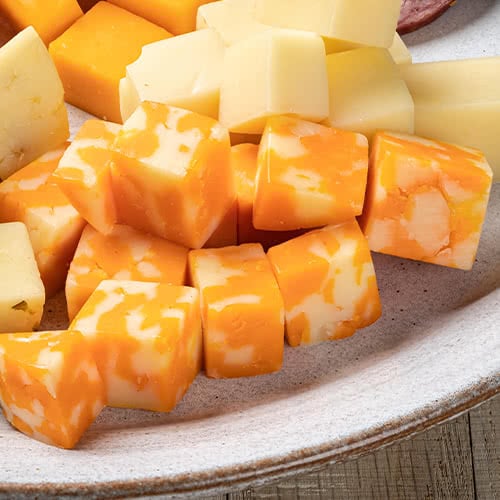
Colby Jack
Colby Jack is a type of semi-soft cheese that is a mixture of Colby and Montery Jack cheeses. The blend gives the cheese a beautiful marbled look that tastes sharp and tangy and has a smooth yet firm texture.
Colby Jack makes an excellent cheese to use in baked recipes since it's a great melting cheese. Use it in dishes that include chicken, beef, eggs, broccoli, bell peppers, jalapenos, mushrooms, and potatoes. For drink pairings, pour a type of whiskey or a bold red wine such as Cabernet Sauvignon, Syrah, or Zinfandel.
- Milk Type: Cow
- Taste: Sharp and tangy
- Texture: Smooth and firm
- Accompaniments: Chicken, beef, eggs, broccoli, bell peppers, jalapenos, mushrooms, potatoes
- Colby Jack Drink Pairings: Whiskey, Cabernet Sauvignon, Syrah, Zinfandel
Types of Semi-Hard Cheese
When cheese is left to age, it develops complexity, a harder paste, and deeper tasting notes, which is what differentiates semi-hard cheese from semi-soft. Semi-hard is aged just enough that it's not meant for grating, but not quite soft enough to be spreadable. Semi-hard cheese is meant for shredding or slicing. Check out these types of semi-hard cheeses below:

Kashkaval
Kashkaval, also spelled Cascaval, is a type of cheese that's very popular in Eastern Europe. In some parts of the region, it's a general name for "yellow cheese", while other regions are firmer on the type of cheese Kashkaval is. This type of cheese can be made from cow and/or sheep's milk and generally has a sharp and salty taste with notes of olive oil and a firm yet creamy texture.
The best food accompaniments for Kashkaval are dried fruit, honey, radishes, black olives, and spring onions. In some Eastern European countries, Kashkaval is cut up, breaded, and deep fried and served as a side or as a free starter as bread would be at a restaurant in America. Kashkaval can also be sliced for a salad or pizza. Pair Kashkaval with a light red wine or a Pilsner.
- Milk Type: Cow and/or sheep
- Taste: Sharp, salty, hint of olive oil
- Texture: Firm and creamy
- Accompaniments: Dried fruit, honey, radishes, black olives, spring onions
- Kashkaval Wine and Beer Pairing: Light red wine or Pilsner

Cheddar
Cheddar cheese is a type of semi-hard cheese made from cow's milk. Originating from the village of Cheddar in Somerset, England, this cheese is the second most popular cheese in America (right after Mozzarella) and the most popular cheese in the United Kingdom. Cheddar has a wonderfully complex flavor profile that tastes umami, sharp, and bold with notes of toasted hazelnuts and whiskey.
This cheese pairs well with cherries, apples, walnuts, mustard, bacon, onion, dill crackers, and hearty bread. Cheddar's soft yet crumbly texture is great for sandwiches, paninis, casseroles, cheese puffs, and mac and cheese. It's also famous for sweet desserts like apple pie. Pair Cheddar with a glass of wine like Zinfandel, Pinot Noir, or Cabernet, or a beer like Porter, Mead, or an Amber Ale.
- Milk Type: Cow
- Taste: Umami, sharp, bold, toasted hazelnuts, whiskey
- Texture: Soft and crumbly
- Accompaniments: Cherries, apples, walnuts, mustard, bacon, onion, dill crackers, hearty bread
- Cheddar Wine and Beer Pairings: Zinfandel, Pinot Noir, Cabernet, Porter, Mead, Amber Ale

Edam
Edam is a type of cheese that originated in the Netherlands, being named after the town of Edam in the northern region of the country. This cheese is made from cow or goat's milk and has a creamy, nutty, and salty taste with a springy and dense texture.
Edam's best food pairings are with peaches, apricots, cherries, and melons, and can be found in recipes such as savory pies, casseroles, paninis, and cheese sauce. Pair your Edam recipes with a glass of Pinot Grigio, Riesling, or Chardonnay to complement its salty and nutty flavors.
- Milk Type: Cow or goat
- Taste: Creamy, nutty, salty
- Texture: Springy and dense
- Accompaniments: Peaches, apricots, cherries, melons
- Edam Wine Pairing: Pinot Grigio, Riesling, Chardonnay

Emmental
Emmental, sometimes known as Emmentaler, looks like the cheese that some people refer to as "Swiss cheese" when in fact Emmental is only a type of Swiss cheese. This cheese is wonderfully sharp and complex with notes of browned butter and nuts. It has a velvety, dense, and springy texture with large holes that are called "eyes" that are formed during its fermentation process.
This cow's milk cheese can accompany fruits like apples, grapes, peaches, and pears. Emmental is great in recipes like cheese souffle, gratins, galettes, fondue, and quiches, especially when caramelized onions, potatoes, bacon, and crusty bread are also present. Pair Emmental with a glass of wine such as Merlot, Riesling, Champagne, or Beaujolais, or with a light Lager or Stout.
- Milk Type: Cow
- Taste: Nutty, slightly sharp, browned butter notes
- Texture: Velvety, dense, springy
- Accompaniments: Apples, grapes, peaches, pears, garlic, caramelized onions, potatoes, bacon, bread
- Emmental Wine and Beer Pairings: Merlot, Riesling, Champagne, Beaujolais, light Lager, Stout

Gouda
Gouda cheese is a type of semi-hard cheese that originated in the Netherlands. Gouda is widely beloved worldwide but is especially celebrated today in the town of Gouda in the Netherlands where a Gouda cheese market takes place every Thursday morning. This cow's milk cheese has wonderful caramel, butterscotch, brown butter, and toffee notes with a slightly crunchy texture and definitive bite.
Gouda tastes great with spicy nuts, olives, oat crackers, date jam, pecans, and arugula. Try using Gouda on a sandwich or in a salad, French onion soup, beer cheese dip, omelets, breakfast casseroles, fondues, tarts, and hand pies. Pair Gouda with a glass of Cabernet Sauvignon or Beaujolais to stand up to Gouda's rich flavor profile.
- Milk Type: Cow
- Taste: Caramel, butterscotch, brown butter, toffee
- Texture: Slightly crunchy with a definitive bite
- Accompaniments: Spicy nuts, olives, oat crackers, date jam, pecans, arugula
- Gouda Wine Pairing: Cabernet Sauvignon or Beaujolais

Gruyere
Gruyere is a type of Swiss cheese that was named after the town of Gruyeres in the canton of Fribourg in Switzerland. It is a cow's milk cheese that tastes sweet, salty, complex, nutty, and earthy. The texture is grainy, flaky, and dense. It has a funky smell and is one of the most popular types of stinky cheese.
Gruyere is exceptional on a charcuterie board with sliced pears, lingonberry jam, figs, pecans, salami, and prosciutto. It's great in hearty recipes like onion soup, vegetable bakes, and savory tarts and scones, especially if they have rosemary or marjoram present. Pair your Gruyere cheese with crispy, acidic, or sweet white wines like Gewurztraminer, Riesling, Pinot Grigio, or Pinot Blanc.
- Milk Type: Cow
- Taste: Sweet, salty, complex, nutty, earthy
- Texture: Grainy, flaky, dense
- Accompaniments: Sliced pears, lingonberry jam, figs, pecans, salami, prosciutto, rosemary, marjoram
- Gruyere Wine Pairing: Gewurztraminer, Riesling, Pinot Grigio, Pinot Blanc

Asiago D'Allevo
- Milk Type: Cow
- Taste: Milky, sharp, intense, piquant, caramelly, savory
- Texture: Smooth but slightly crumbly
- Accompaniments: Figs, grapes, candied pecans, and rustic bread such as sourdough, baguette, or ciabatta
- Asiago D'Allevo Wine Pairing: Orvieto or Soave
Types of Hard Cheese
Best for grating or thinly slicing, this dry-textured cheese is potent and deeply savory. Therefore, a little bit goes a long way. Often crunchy due to the moisture loss and small calcium lactate crystals, firm cheese offers a dynamic texture and mouthfeel when sliced thinly and paired with jams or grated on top of finished dishes. Below are a few popular types of hard cheese.
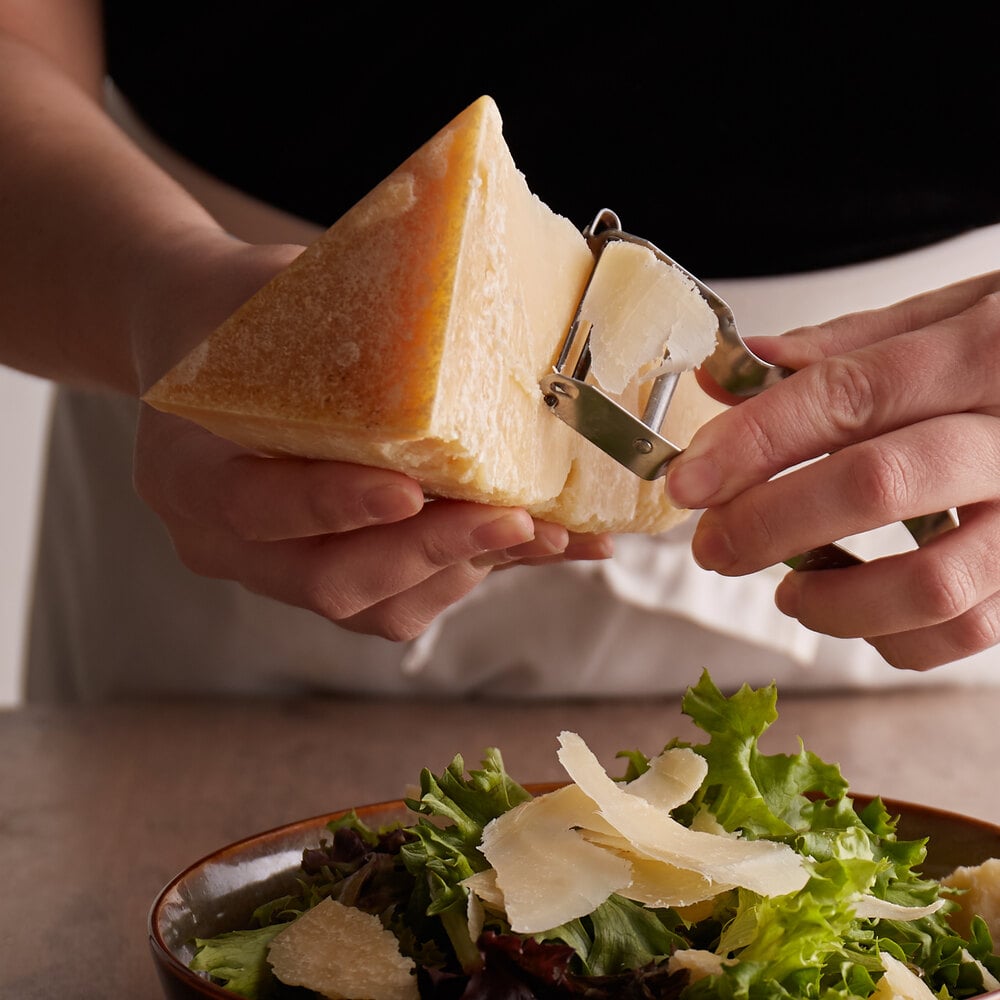
Grana Padano
Grana Padano is a type of cheese that originated in Northern Italy. This cow's milk cheese is full-bodied and savory with a grainy, rickety, hard, and crunchy texture.
Grana Padano is excellent with figs, dried fruits, honey, apples, arugula, eggplant, roasted red pepper, potatoes, Tuscan kale, and fish. It can be cut up for a charcuterie board, grated into sauces and soups, or used as a finishing touch on top of cooked fish, pasta, and pizza. Wine pairings for Grana Padano include Gavi, Chianti, Barbaresco, Barolo, Lambrusco, and Amarone.
- Milk Type: Cow
- Taste: Full-bodied, savory
- Texture: Grainy, rickety, hard, crunchy
- Accompaniments: Figs, dried fruits, honey, apples, arugula, eggplant, roasted red pepper, potatoes, Tuscan kale, fish
- Grana Padano Wine Pairing: Gavi, Chianti, Barbaresco, Barolo, Lambrusco, Amarone

Manchego
Manchego is a sheep's milk cheese with origins in the La Mancha region of Spain. This type of cheese has a creamy, tangy, semi-sweet, and well-developed flavor profile with a flaky, grainy, and slightly crystallized texture. Manchego has a distinctive herringbone rind that can range in color from purple, to brown, and green.
Honey, Marcona almonds, marmalade, green olives, roasted red peppers, and sun-dried tomatoes all pair well with Manchego. It's a great cheese for a variety of Spanish-style tapas or for use in salads, frittatas, or flatbreads. Manchego pairs well with both beer and wine, so reach for a Stout, Porter, Sherry, or Riesling when enjoying Manchego.
- Milk Type: Sheep
- Taste: Creamy, tangy, semi-sweet, well-developed
- Texture: Flaky, grainy, slightly crystalized
- Accompaniments: Honey, Marcona almonds, marmalade, green olives, sun-dried tomatoes, roasted red peppers
- Manchego Wine and Beer Pairings: Stout, Porter, Sherry, Riesling

Parmigiano-Reggiano
Parmigiano-Reggiano is a type of hard cheese that can only be made in the Parma, Modena, and Reggio Emilia regions of Italy, with some areas of Bologna and Mantua also included. It is often confused for Parmesan, but Parmesan is different from Parmigiano-Reggiano because of Italy's Denominazione di Origine Protetta laws, making Parmesan an inexpensive and lower quality alternative to the protected Parmigiano-Reggiano.
This cow's milk cheese is nutty, salty, spicy, and slightly floral with a dry, crackly, crumbly, and rough texture. It's perfect for grating on top of pasta, pizza, salad, and any dish that could benefit from a sprinkling of pungent cheese. Parmigiano-Reggiano pairs especially well with prosciutto, balsamic vinegar, spiced quince, and spiced nuts, and is great with a glass of Cabernet Sauvignon, Sauvignon Blanc, Shiraz, Chardonnay, Merlot, or Sangiovese.
- Milk Type: Cow
- Taste: Salty, nutty, spicy, slightly floral
- Texture: Dry, crackly, crumbly, rough
- Accompaniments: Prosciutto, balsamic vinegar, spiced quince, spiced nuts, pasta
- Parmigiano-Reggiano Wine Pairing: Cabernet Sauvignon, Sauvignon Blanc, Shiraz, Chardonnay, Merlot, Sangiovese

Pecorino Romano
Pecorino Romano is an Italian sheep's milk cheese, which is exactly where its name stems from as "pecora" translates to "sheep" in Italian. This type of cheese is aromatic, peppery, and pungent with a brittle and firm texture.
Pecorino Romano pairs well with hearty ingredients such as dry-cured meats, walnuts, winter vegetables, and sausages. Jam, honey, and balsamic vinegar's sweet and acidic tastes also balance out Pecorino Romano's pungent flavor. Pair this type of cheese with a glass of Chianti, Nebbiolo, Pinot Noir, Chardonnay, or Prosecco.
- Milk Type: Sheep
- Taste: Aromatic, peppery, pungent
- Texture: Brittle and firm
- Accompaniments: Dry-cured meats, walnuts, hearty winter vegetables, sausages, jams, honey, balsamic vinegar
- Pecorino Romano Wine Pairing: Chianti, Nebbiolo, Pinot Noir, Chardonnay, Prosecco

Mimolette
Mimolette is a cow's milk cheese that originated in France. It is said that Mimolette was inspired by Holland's round cheeses such as Edam. Mimolette is sweet, buttery, and smooth with a dense yet chewy texture and famous dark orange color that comes from the natural food dye of annatto seeds.
When placed on a charcuterie board, position Mimolette next to dark chocolate, grapes, green apples, honey, prosciutto, and nuts. Mimolette is wonderful when grated on top of dishes like omelets, warm entrees with meat or fish, or on top of salads. Pair Mimolette with a rustic glass of Cabernet Sauvignon, Languedoc, or Malbec to round out your meal.
- Milk Type: Cow
- Taste: Sweet, buttery, smooth
- Texture: Dense and chewy
- Accompaniments: Dark chocolate, grapes, green apples, honey, prosciutto, nuts
- Mimolette Wine Pairing: Cabernet Sauvignon, Languedoc, Malbec
How Many Types of Cheese Are There?
Cheese is an ancient ingredient that's prepared in different ways by cultures all over the world, so it's difficult to estimate how many types of cheese there are. We can say for sure that there are thousands of types of cheese; in the country of France alone, some people estimate that there are over 1,000 distinct varieties of cheese! The differences between these varieties can play an important cultural role in the areas they originate from.
Types of Italian Cheese
Italy is known for its incredible food and wine culture, and cheese plays a big role in its reputation. Here are a few of the most popular Italian cheeses.
- Parmigiano-Reggiano
- Mozzarella
- Gorgonzola
- Ricotta
- Mascarpone
- Pecorino Romano
- Grana Padano
- Taleggio
- Provolone
Types of Mexican Cheese
Cheese is incredibly important to the food culture in Mexico. Tacos, enchiladas, tamales, and other famous Mexican dishes are deepened in flavor when savory Mexican cheese is added. Check out a few of the most popular types of Mexican cheese below.
- Cotija
- Oaxaca
- Chihuahua
- Queso Fresco
- Enchilada
- Panela
- Asadero
Types of Swiss Cheese
Swiss cheese is known for being the healthiest of cheeses as it's lower in fat and sodium than in other countries. Swiss cheese usually has a strong taste and ideal meltability, so check out a few of the most popular Swiss cheeses below:
- Emmental
- Gruyere
- Raclette
- Sbrinz
- Appenzeller
- Sbrinz
Types of French Cheese
The French are very proud of their cheese, and rightfully so: the Romans introduced it to them, but the French perfected it in their monasteries. Today, French cheese is considered the stinkiest and most indulgent, so here are a few of the most common French cheeses to try:
- Brie
- Camembert
- Mimolette
- Comte
- Fourme d'Ambert
- Roquefort
- Chevre
- Boursin
- Munster
- Chaource
Related Resources

January 2025 WebstaurantStore Coupon Code
The holiday season is over, and to ring in the new year and combat the post-holiday blues, you can find amazing deals on important items here at WebstaurantStore all January long! From essential coffee service equipment to ingredients and supplies for your favorite winter recipes, we have a slew of great deals to warm you up this cold season! Check out our selection of sale items below and don't forget to enter the code FROSTY26 at checkout to enjoy 10% off your purchases! Looking to save even more? Check out the new Webstaurant Rewards® Visa Business Card ! Sign up for a new card today and start earning rewards on every WebstaurantStore purchase, and save on a WebstaurantPlus subscription. Explore incredible deals on winter disposable item

How to Use Cheese Knives
You may have a cheese knife set in your home but may not exactly know what task each one of those knives is made to perform. Just as a chef will use various types of knives in a day to increase their efficiency, each cheese knife type has a purpose to improve the user experience. We prepared a guide and a printable cheese knife resource to help you use the proper knife for the cheeses you are planning to serve. Shop All Cheese Knives How to Choose Cheese Knives Video Watch the video below to learn more about cheese knives! Types of Cheese Knives According to dining etiquette , a cheese knife should not be used on more than one cheese type on your cheese board. Each cheese knife performs a purpose and was built to perform it well. Here is a
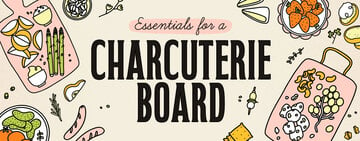
Charcuterie Board Essentials
Charcuterie boards are a trending appetizer for caterers and restaurants, offering a delicious spread of snacks in an artistic presentation . They allow venues to unleash their creativity while using low-cost ingredients they might have left over on their shelves. Before you start building your unique board , use our list of charcuterie board essentials to ensure you have everything you need. Shop All Charcuterie Boards Use the following links to find charcuterie board essentials: Meat Cheese Crackers Bread Dips Garnish Utensils Board Themes Tips


